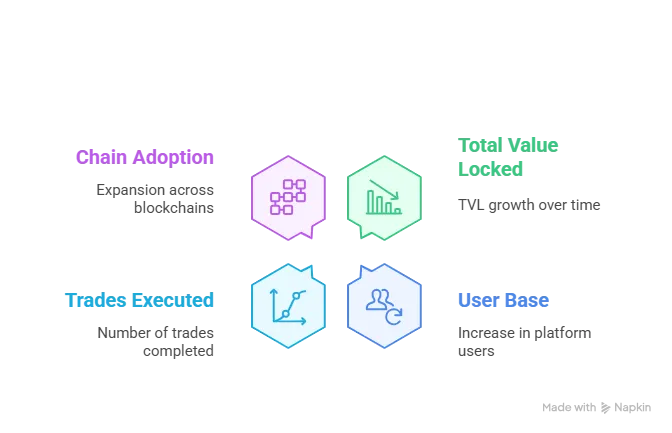Not every founder dreams of building something from scratch. Shocking? Not really. When you’re knee-deep in funding rounds, gmx clone sleepless beta testing nights, and ever-demanding user expectations, reinventing the wheel suddenly doesn’t sound that sexy. Especially in the high-stakes world of crypto derivatives and decentralized exchanges. Speed matters. Budget matters. Execution matters more than a “from-zero-to-hero” fantasy.
Take it from many of our startup clients—they’ve been down the rabbit hole of custom DeFi platform development. Burned timelines. Ballistic budgets. And don’t even get us started on the post-launch bug hunts. So when they stumble upon our GMX clone? It’s like spotting an oasis in a very scorched crypto desert. Fast-track launch, proven functionality, room to customize if they want—it’s a no-brainer.
Miracuves isn’t here to just sling code. We’re here to be the launchpad (pun intended) for founders who’d rather spend their time building communities and generating yield than debugging liquidity pools. So, what makes our GMX clone the go-to over custom builds? Let’s break it down.
Why the GMX Hype? A Quick Recap
Before diving into the clone debate, let’s talk about why GMX took the DeFi world by storm.
GMX is a decentralized perpetual exchange that lets users trade BTC, ETH, and other top cryptos with leverage—right from their wallets. No KYC. No intermediaries. Just smooth, smart contract-powered trades on Arbitrum and Avalanche. Oh, and it uses a unique GLP liquidity model that rewards liquidity providers handsomely while keeping the ecosystem sustainable.

Custom Development—The Harsh Reality
It’s Not Just Coding, It’s a Marathon
Building a decentralized leverage trading platform is like assembling a spaceship in your garage. You need smart contracts, robust oracles, fee models, liquidity mechanisms, UI/UX, multi-chain support—and a ton of testing. And then audits. And post-audit bug fixing. And then user feedback loops. You get it.
The Cost Spiral
Even with a scrappy dev team, building a full-scale GMX alternative from scratch could bleed you dry. We’re talking $150K–$400K+ depending on features and security layers. Oh, and that’s before marketing, community, or liquidity incentives.
Time Is Not on Your Side
By the time your custom platform is “ready,” the market may have shifted. Narratives change fast in crypto. If you’re building for Q1, you better be ready before Q1, not after it.
Read More : Revenue Model of GMX: How This Decentralized Exchange Makes Money
Why Startups Love Our GMX Clone
Launch in Weeks, Not Quarters
With our pre-built GMX clone, you skip the base-building pain and go straight to personalization. Want your own branding, chain preference, tokenomics? We’ve got you. You could be testing your MVP while others are still designing their whitepapers.
Battle-Tested Codebase
Our GMX clone is not some weekend hack. It’s rigorously tested, optimized for performance, and built to scale. The core logic—margin trading, GLP-style liquidity, multi-asset support—is already sorted. We simply tailor the rest to your needs.
Built-In Monetization
Fee distribution, staking rewards, referral incentives—it’s all wired in. You focus on attracting users; we’ve already built the financial engine.
Security First (Always)
We know smart contracts are the backbone here. That’s why every GMX clone from Miracuves comes with optional third-party audit support, internal penetration testing, and detailed documentation. No shortcuts. No compromises.
Freedom to Customize—If You Want
Want to integrate a custom wallet? Add NFT perks for top traders? Include a multi-chain bridge? You got it. Our clone isn’t a one-size-fits-all straightjacket—it’s a springboard.
Read More : Top 5 Mistakes Startups Make When Building a GMX Clone
Real Stories, Real Impact
One of our clients, a crypto startup from Singapore, approached us in early 2024. They were chasing the perpetual DEX market with a vision to dominate Southeast Asia. The catch? They had a 90-day deadline and a shoestring budget.
Enter Miracuves. With our GMX clone, they launched within 40 days. No crazy overhead. No existential stress. Within the first month post-launch, they had over $2M in daily trading volume and a thriving Telegram community of 12,000+ members.
That’s not just rapid development. That’s accelerated success
GMX Clone vs Custom Build
| Feature | GMX Clone by Miracuves | Custom Development |
| Launch Time | 3-9 days | 4–6 Months+ |
| Cost | $3299 | $150K–$400K+ |
| Audit-Ready Code | – | (Extra Cost) |
| Monetization Features | Built-in | Requires Development |
| Customization Flexibility | High | Full (but costly) |
| Support & Maintenance | Ongoing | Varies by dev team |
Read More : Best GMX Clone Scripts in 2025: Features & Pricing Compared
Conclusion:
The DeFi world doesn’t wait. If you’ve got a killer idea, you need to ship fast, secure your niche, and start compounding network effects—yesterday. Custom development might sound romantic, but in crypto, speed and stability are king.
According to Statista, the DeFi market has seen remarkable growth over the past few years, with total value locked (TVL) increasing significantly as more users and platforms embrace decentralized finance.
At Miracuves, we help innovators launch high-performance app clones that are fast, scalable, and monetization-ready. Ready to turn your idea into reality? Let’s build together.
FAQs
What exactly is a GMX clone?
A GMX clone is a ready-made decentralized derivatives trading platform replicating the core features of GMX, like perpetual swaps, leverage trading, GLP pools, and oracle pricing—customizable for your brand and use case.
How customizable is the GMX clone?
Very. You can change UI/UX, tokens, leverage settings, supported chains (like Arbitrum or Base), referral systems, and more.
Is the clone safe and secure?
Absolutely. We implement rigorous QA, internal audits, and support third-party security checks. Security is never optional in DeFi.
Can I add my own token to the GMX clone?
Yes! We can integrate your utility or governance token for fees, rewards, and even GLP participation.
How long will it take to launch?
You can expect to go live in 3-9 days, depending on your customization needs. We prioritize both speed and stability.
Is it cheaper than building from scratch?
Without a doubt. You save over 70% in development costs, not to mention months of engineering time and audit headaches.
Related Article :








